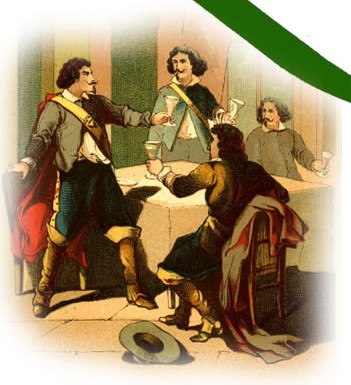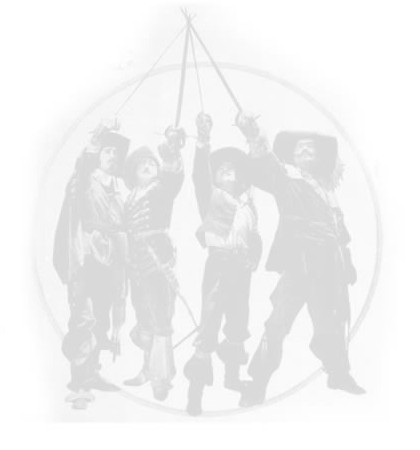On the 4th of February 1360, four Gascon lords gathered in the city of Toulouse to sign a pact.
 Rather, it was a kind of covenant in which the four parties swore an oath which they then validated by posing their seals. When we look closer, as did Henri Morel (*), we are nonetheless perplexed as to the nature of the document. Was it a pact, an alliance, a sacred covenant or just a simple association? This singular act is extraordinary in more ways than one. Here we find a rather uncommon engagement between these four men, a kind of marriage, in which they swore their bodies (mutual defence) and their spirits (oaths), and that only death could tear asunder.
Rather, it was a kind of covenant in which the four parties swore an oath which they then validated by posing their seals. When we look closer, as did Henri Morel (*), we are nonetheless perplexed as to the nature of the document. Was it a pact, an alliance, a sacred covenant or just a simple association? This singular act is extraordinary in more ways than one. Here we find a rather uncommon engagement between these four men, a kind of marriage, in which they swore their bodies (mutual defence) and their spirits (oaths), and that only death could tear asunder.
These four Gascons sealed an alliance that could be summarized by the oath that the four musketeers –themselves Gascons—swore to each other six centuries later in Alexander Dumas’ novel:
“All for one and one for all!”
The preamble of the historical pact reads:
May all who read and heed these letters know that we, Jean d’Armagnac, Viscount of Fezenzaguet and of Bruilhois, Arnaud Guilhem, Count of Pardiac, Jean de Lomagne, Lord of Fimarcon and Jean de la Rivière, Lord of Aure, For the honor of the Holy Trinity and of the Holy Court of Celestial Paradise and for the honor of the Holy Christian Faith and the Holy Church of God our Lord and his Crown, to prevent the misdeeds and acts of pillage that we presently see being committed by the world and in order to support and share the burden of one another and assure the conservation of our states and our lands, and mindful that true friendship and unity must be defended by our person and our possessions, have promised, and promise and affirm, each of us, unity and loyalty one to the other, and hereby laying our right hands on the Holy Gospels of our Lord and on the figure of the true Cross and by kissing each one of us the other, we have made and hereby make, by these acts, alliances and proprieties, grants and agreements, in the form and substance that follow…
We will summarize below the fourteen articles of the covenant that follow:
First, the four contracting parties owe one another mutual aid for all “conflicts, necessities, wars or trials” that one of them might face, regardless of whether or not the others were originally involved in the disagreement. The only exceptions are those cases concerning the Church, the King of France, the Count of Armagnac and a few other seigneurs.
This pledge of mutual assistance is very serious because if one of their number were engaged in a war, the other three, if asked, would have to immediately rush to his aid. Each of them was also obliged to keep a private army of fifty men-at-arms and one hundred footmen. Even the subject of costs was broached, which were redistributed in such a way that each one took on the expenses of his own troops and the operations in which they were engaged.
If one of the parties had a legitimate reason for not fulfilling his duties, the others were obliged to take his place.
The pact also foresaw cases where two of the four might be entangled in two different wars at the same time. In that case, after deliberation, the others were to aid both of them in turn according to the degree of urgency.
The same was true in the event of a lawsuit. Legal expenses were, of course, to be paid by the interested party, but in the event that the adverse party proved to be more powerful, thus increasing the appellant’s expenses beyond his means, his associates could be called upon to share the expenses.
Next, after mutual aid, this covenant stipulated an obligation to hold council. That is, none of the parties could give aid –even in time of war—to another without the advice and consent of the others.
There followed next a series of articles designed to settle any disputes that might arise between the associates.
Then, came those articles which bound the associates to protect the lands of their comrade in his absence.
They were also obliged to support the caretakers of the absent party’s property; and if his vassals decided to wage war, his associates, after consultation, were to come to their aid.
Finally, “particular dispositions obliged the associates to keep any secrets that were confided to them and to do their utmost to ward off any dangers that might menace their allies, or at the very least to warn them.”
The covenant ended with an oath, as the four seigneurs declared themselves bound by this pact for the rest of their lives “that no discord, war or trial can destroy.”
Henri Morel, who discovered the association between the four Gascon seigneurs, has done an analysis that allows us to better understand the depth of the pact.
He starts by taking a look at the four seigneurs themselves. Who were they?
All four descended from the Gascon middle nobility, somewhere between the “grand” seigneurs like the Count of Armagnac or the Count of Foix and the little local seigneurs who were actually their vassals. The four seigneurs came under the direct authority of the King of France.
True, they were French, but French in the border region that was eastern Gascony at that time; and their possessions stretched from the Garonne River in the north all the way to the Pyrenees. And so, they were within a stone’s throw of lands occupied by the vassals of the English King.
Because of this, the accidents of war and successive treaties led them to change masters quite often, and even if they appeared to be loyal subjects of the King of France, it certainly had not been the case for long. And yet, the primary goal of their alliance was to defend the interests of the King of France and the Church, and eventually their own territories and lands.
We must remember that on that February day in 1360, the unfortunate Peace of Brétigny, ceding all of Aquitaine to the English, would be concluded in just a few weeks. In the meantime, King Jean II was a prisoner of the English.
Faced with this impotence on the part of the French throne (English attacks throughout the territory, unrest, acts of pillage, etc.) and in a country where they didn’t know if they would be French or English when they woke up in the morning, the four seigneurs sealed an alliance that was above all defensive, designed to protect their common interests.
But was it only a defensive alliance?
The four seigneurs spoke of an alliance, but in fact it was an act that was “much more complex”.
But, though it is tempting to cite the example of the feudal leagues dating from 1314 and that were popping up all over the kingdom, and whose reason to exist was to give “mutual aid and assistance against the abuses of royal power”, it must be recognized that that the leagues had only that one and well-defined objective. This was not the case for the covenant. It went far beyond that.
“What is striking (…) is to see an important notion come out of this: the common interest of the four parties that is not only the sum of their separate interests, exactly as if this covenant created a veritable community, a universitas.”
Henri Morel.
Although all the parties were bound by obligations, on the other hand not a single one of them could undertake an important action without having before consulted the other three.
More, each of the four had to give a kind of blank check to the other three to interfere in his affairs, creating limitations on their freedom of action; a loss of freedom to which all four parties agreed.
“But this limitation can only be exercised for their common good, in the general interest of their association, of which the objective is precisely to create this common good. It is for that reason that the covenant made by these four Gascon seigneurs is something more than a simple alliance: they formed, whether they knew it or not, a collective entity, superior to each one of them because everything was reduced to the interest of the community.” Henri Morel.

Here we are very close indeed to the oath, “All for one and one for all!”…
Even more so when we consider that this community had no chief, no party above the others, which is remarkable in those times when social relationships were very hierarchical. The pact was not a legal agreement, either; it was the spontaneous creation of these four men.
“If we wish to define the real nature of this bond that united them (…) we must look for it in that institution that was parallel to feudalism: the family that, it too, knew only personal bonds. Certainly not a family by blood, by lineage, but this sort of relatedness created by an exchange of oaths (…) For, it is the oath that creates the real bond between these four seigneurs, that forms their compagnie (the very word appears in the pact).” Henri Morel.
And, of course, this pact could only be broken by death.
They were four, they were Gascons, and they were men of war. They came together by means of a rather uncommon pact that made them united and indivisible.
It is unlikely that Alexander Dumas knew of this alliance, even if he did conduct, along with his collaborators, considerable research before writing his novel. But the coincidence is interesting.
Might there exist, in the Gascon spirit, a kind of seed of solidarity that was activated several centuries later by the magic words “All for one and one for all”? That magic incantation that has become the very motto of unconditional union…
(*) Henry Morel, Une association de seigneurs gascons au XIVe siècle. PUF, « Mélanges d’histoire du Moyen Age dédiés à la mémoire de Louis Halphen »
